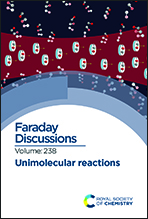Energy-resolved and time-dependent unimolecular dissociation of hydroperoxyalkyl radicals (˙QOOH)†
Abstract
Hydroperoxyalkyl radicals (˙QOOH) are transient intermediates in the atmospheric oxidation of volatile organic compounds and combustion of hydrocarbon fuels in low temperature (<1000 K) environments. The carbon-centered ˙QOOH radicals are a critical juncture in the oxidation mechanism, but have generally eluded direct experimental observation of their structure, stability, and dissociation dynamics. Recently, this laboratory demonstrated that a prototypical ˙QOOH radical [˙CH2(CH3)2COOH] can be synthesized by an alternative route, stabilized in a pulsed supersonic expansion, and characterized by its infrared (IR) spectroscopic signature and unimolecular dissociation rate to OH radical and cyclic ether products. The present study focuses on a partially deuterated ˙QOOD analog ˙CH2(CH3)2COOD, generated in the laboratory by H-atom abstraction from partially deuterated tert-butyl hydroperoxide, (CH3)3COOD. IR spectral features associated with jet-cooled and isolated ˙QOOD radicals are observed in the vicinity of the transition state (TS) barrier leading to OD radical and cyclic ether products. The overtone OD stretch (2νOD) of ˙QOOD is identified by IR action spectroscopy with UV laser-induced fluorescence detection of OD products. Direct time-domain measurement of the unimolecular dissociation rate for ˙QOOD (2νOD) extends prior rate measurements for ˙QOOH. Partial deuteration results in a small increase in the TS barrier predicted by high level electronic structure calculations due to changes in zero-point energies; the imaginary frequency is unchanged. Comparison of the unimolecular decay rates obtained experimentally with those predicted theoretically for both ˙QOOH and ˙QOOD confirm that unimolecular decay is enhanced by heavy-atom tunneling involving simultaneous O–O bond elongation and C–C–O angle contraction along the reaction pathway.

- This article is part of the themed collection: Unimolecular reactions


 Please wait while we load your content...
Please wait while we load your content...
